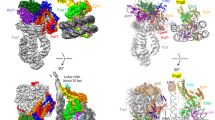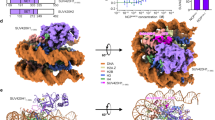Abstract
Methylation of histone H3 lysine 9 is an important component of the 'histone code' for heterochromatic gene silencing. The SET domain-containing Clr4 protein, a close relative of Su(var)3-9 proteins in higher eukaryotes, specifically methylates lysine 9 of histone H3 and is essential for silencing in Schizosaccharomyces pombe. Here we report the 2.3 Å resolution crystal structure of the catalytic domain of Clr4. The structure reveals an overall fold rich in β-strands, a potential active site consisting of a SAM-binding pocket, and a connected groove that could accommodate the binding of the N-terminal tail of histone H3. The pre-SET motif contains a triangular zinc cluster coordinated by nine cysteines distant from the active site, whereas the post-SET region is largely flexible but proximal to the active site. The structure provides insights into the architecture of SET domain histone methyltransferases and establishes a paradigm for further characterization of the Clr4 family of epigenetic regulators.




Similar content being viewed by others
References
Wu, J. & Grunstein, M. Trends Biochem. Sci. 25, 619–623 (2000).
Zhang, Y. & Reinberg, D. Genes Dev. 15, 2343–2360 (2001).
Jenuwein, T. & Allis, C.D. Science 293, 1074–1080 (2001).
Strahl, B.D. & Allis, C.D. Nature 403, 41–45 (2000).
Turner, B.M. Bioessays 22, 836–845 (2000).
Grewal, S.I. & Elgin, S.C. Curr. Opin. Genet. Dev. 12, 178–187 (2002).
Richards, E.J. & Elgin, S.C. Cell 108, 489–500 (2002).
Jenuwein, T. Trends Cell Biol. 11, 266–273 (2001).
Noma, K., Allis, C.D. & Grewal, S.I. Science 293, 1150–1155 (2001).
Rea, S. et al. Nature 406, 593–599 (2000).
Nakayama, J., Rice, J.C., Strahl, B.D., Allis, C.D. & Grewal, S.I. Science 292, 110–113 (2001).
Lachner, M. & Jenuwein, T. Curr. Opin. Cell Biol. 14, 286–298 (2002).
Horita, D.A., Ivanova, A.V., Altieri, A.S., Klar, A.J. & Byrd, R.A. J. Mol. Biol. 307, 861–870 (2001).
Lachner, M., O'Carroll, D., Rea, S., Mechtler, K. & Jenuwein, T. Nature 410, 116–120 (2001).
Bannister, A.J. et al. Nature 410, 120–124 (2001).
Akhtar, A., Zink, D. & Becker, P.B. Nature 407, 405–409 (2000).
Maison, C. et al. Nature Genet. 30, 329–334 (2002).
Volpe, T.A. et al. Science 297, 1833–1837 (2002).
Hall, I.M. et al. Science 297, 2232–2237 (2002).
Tamaru, H. & Selker, E.U. Nature 414, 277–283 (2001).
Min, J., Landry, J., Sternglanz, R. & Xu, R.M. Cell 105, 269–279 (2001).
Cheng, X. & Roberts, R.J. Nucleic Acids Res. 29, 3784–3795 (2001).
Zhang, X. et al. Cell 111, 117–127 (2002).
Otwinowski, Z. & Minor, W. Methods Enzymol. 276, 307–326 (1997).
Terwilliger, T.C. & Berendzen, J. Acta Crystallogr. D 55, 849–861 (1999).
Jones, T.A., Zou, J.Y., Cowan, S.W. & Kjeldgaard, M. Acta Crystallogr. A 47, 110–119 (1991).
Brunger, A.T. et al. Acta Crystallogr. D 54, 905–921 (1998).
Kraulis, P.J. J. Appl. Crystallogr. 24, 946–950 (1991).
Merritt, E.A. & Bacon, D.J. Methods Enzymol. 277, 505–524 (1997).
Carson, M. Methods Enzymol. 277, 493–505 (1997).
Nicholls, A., Sharp, K.A. & Honig, B. Proteins 11, 281–296 (1991).
Acknowledgements
We thank A. Saxena, A. Heroux, D. Schneider and M. Becker for technical assistance, J.-I. Nakayama for help in protein expression, N. Tolia and L. Henry for comments on the manuscript. The work is supported by NIH grants to X.Z., X.C., S.I.G and R.M.X, by a grant from the Ellison Foundation to S.I.G., and by a grant from the W. M. Keck foundation to R.M.X.
Author information
Authors and Affiliations
Corresponding author
Ethics declarations
Competing interests
The authors declare no competing financial interests.
Rights and permissions
About this article
Cite this article
Min, J., Zhang, X., Cheng, X. et al. Structure of the SET domain histone lysine methyltransferase Clr4. Nat Struct Mol Biol 9, 828–832 (2002). https://doi.org/10.1038/nsb860
Received:
Accepted:
Published:
Issue Date:
DOI: https://doi.org/10.1038/nsb860
- Springer Nature America, Inc.





